
Navigation / Home / DNA Project / Name Index / Pictures / Stories / Obits / Generation 1 / Generation 3
Boat(w)right Family Genealogy in America
Generation 2
2A. ELIZABETH BOTWRIGHT (JOHN2, Not Yet Determined1) was born ca. 1634 in Cambridge, Cambridgeshire, England, and died 1636 in Cambridge, Cambridgeshire, England.
Notes for ELIZABETH BOTWRIGHT:
Elizabeth was baptised at the Great St. Mary's Church in Cambridge, England on May 22, 1634.
Elizabeth was buried on April 10, 1636 in Cambridge, Cambridgeshire, England.
2. JOHN BOTWRIGHT, JR. (JOHN2, Not Yet Determined1) was born 1635 in Cambridge, Cambridgeshire, England, and died Bef. 1704 in New Kent County, Virginia. He married ELIZABETH in ca. 1676 in Virginia. She was born ca. 1646 in England, and died in Virginia.
Notes for JOHN BOTWRIGHT, JR.:

John's Signature is from the York County Courthouse records, (record 5 below). The coach box is said to have belonged to John, the original Boatwright immigrant to America. The box has been passed down through the James Boatwright (b. 1745 - Virginia) family and is now owned by Dan Boatwright.
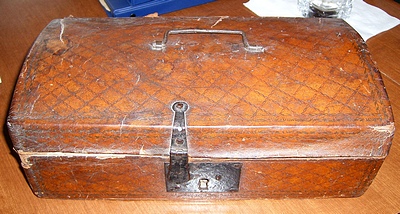
John was baptised at the Great St. Mary's Church in Cambridge, England on January 10, 1635.
Our ancestor, John Botwright, Jr. traveled from Cambridge, England to the new world of Virginia in the mid 1600's. John, Jr. signed on as an indentured servant. It must be emphasized that the indentured servants were not slaves, and that at the expiration of their terms there was no barrier, legal, racial, or social to their advancement. The terms of indenture not only took for granted that the servant, upon completing his contract would establish himself as a proprietor, but usually made it obligatory for the master to furnish him with the equipment necessary for his new life. In exchange for his passage to America, young John agreed to work as an indentured servant for four to seven years. This was a very common way of attracting people to the new world: the promise of a bright future, land ownership and freedom, in exchange for three to seven years of hard labor. John's headright was granted to Humphrey Dennis, of Virginia, in 1654, in exchange for the payment of John Jr.'s passage to Virginia.
"Indenture" is a term from English Common Law which, in the 17th century, generally meant: "under contract". Indentured servants (or laborers under contract) were commonplace in Colonial Virginia during that period. Historians estimate that:
About 70% of migrants from England who came between 1630-1660 were indentured
servants;
Most indentured servants were young, 15-25, and single;
Males servants outnumbered female servants;
Indentures were typically 4-7 years in duration;
Trade in indentured servants peaked about 1620-1680, but lasted until the 1770s.
The following excerpts come from Jack P. Greene’s book The Pursuits of Happiness:
The Social Development of Early Modern British Colonies and the Formation of American Culture:
"Between 1607 and 1660, the English emigration to America had thus produced on the eastern coastline of continental North America two simplified expressions of contemporary English society. But they were extremely different from each other. Chesapeake society was highly materialistic, infinitely more secular, competitive, exploitative, and very devoted to commercial agricultural production for an export market. Its high demand for labor and high mortality rates combined to produce a population that was disproportionately male, young, single, immigrant and mobile. The process of family formation was slow. Social institutions were weak, authority was tenuous, and individualism was strong. With only a slowly developing sense of community, the Chesapeake exhibited a marked proclivity toward public discord.
If, in many of these respects, the Chesapeake was "the most dynamic and innovative society on the Atlantic seaboard" during the early seventeenth century, the puritan colonies of New England were the most self-consciously and successfully traditional. With low mortality, rapid population growth, a benign disease environment, and a far more fully and rapidly articulated Old World-style society, the intensely religious colonies of Massachusetts, Connecticut, and New Haven, moved by powerful millennial and communal impulses, exhibited rapid community and family development. With strong patriarchal families, elaborate kinship networks, and visible and authoritative leaders, localities quickly developed vigorous social institutions, including many schools, and deeply rooted populations. Mostly involved in cereal agriculture and with no generalized source of great economic profit, the puritan colonies displayed a relatively egalitarian wealth structure and an extraordinarily low incidence of social discord and contention. It is hardly possible to conceive how any two settlements composed almost entirely of Englishmen could have been much more different.
The most important lesson to take away from Jamestown is that "blood, sweat, and tears" – not any abstract philosophy – is what enabled "Virginia” to supplant “Tsenacommacah." The English burned Indian villages up and down the James River. They sailed up the James and its tributaries in their boats and pacified the countryside with a mobile strike force armed with rifles and heavy armor. They burned Indian fields to reduce the Powhatans to starvation.
Ultimately, the English succeeded after they finally adopted a realistic appraisal of their military circumstances in Virginia. They built the wall across the peninsula, expelled all the Indians, and imported as many White colonists from England as possible. They forbid trading with the enemy. They thought squarely in terms of their own self interest, not wishy washy idealism. …"
According to the Historians:
Indentured servants were often scorned in their time as beggars and riffraff. In reality they probably represented a broad spectrum of working people from English society. They included the desperately poor (the majority) and the middle class. Most of them were probably farmers or unskilled laborers during the early years.
Tobacco quickly became the principal source of cash in early Virginia and tobacco farming demanded a large and ever expanding work force, a workforce which could not be provided from within the colony. Ergo, English entrepreneurs were encouraged to recruit large numbers of laborers from England to the tobacco plantations. Men, women, and sometimes children signed a contract with a "master" to serve a term of 4 to 7 years. In exchange for their service, indentured servants received their passage paid from England, and food, clothing and shelter once they arrived in the colony.
When the contract had expired, the servant was paid "freedom dues" and allowed to leave the plantation. Freedom dues usually consisted of corn, tools and clothing.
During the time of his/her indenture, a servant was considered his master's personal property and the servant's contract could be bartered, inherited or assigned. While a servant, a person could not marry or have children. A master's permission was needed to leave the plantation, to perform work for someone else, or to receive money for personal use. An "unruly" servant was punished by whipping for improper behavior.
Labor was hard and living conditions were generally harsh for indentured servants. Many servants had difficulty adjusting to the climate and native diseases of southeast (Tidewater) Virginia, and many servants did not live to receive their freedom. Runaway servants, of which there were many, were punished by increasing their time of service if they were captured.
Conditions changed in Virginia, however, and, by 1700, recruitment of tobacco plantation labor from England was no longer as important due to the increasing availability of African slaves for the harsh plantation work. At that point, English artisans and skilled labor became important and the nature of the indentured servant trade from England changed. Later in the 1700s, England transported convicts, both men and women, to Virginia to be sold to plantation owners as another form of labor.
Headrights:
In order to encourage immigration into the colony, the Virginia Company, meeting in a Quarter Court held on 18 November 1618, passed a body of laws called Orders and Constitutions which came to be considered "the Great Charter of privileges, orders and laws" of the colony. Among these laws was a provision that any person who settled in Virginia or paid for the transportation expenses of another person who settled in Virginia should be entitled to receive fifty acres of land for each immigrant. The right to receive fifty acres per person, or per head, was called a headright. The practice was continued under the royal government of Virginia after the dissolution of the Virginia Company, and the Privy Council ordered on 22 July 1634 that patents for headrights be issued.
Although seldom used during the eighteenth century, the procedure remained in effect until the passage of an act in the session begun in May 1779 which, in adjusting and settling titles to lands, gave a period of twelve months from the end of the legislative session for such rights to be claimed or be considered forfeited.
A person who was entitled to a headright usually obtained a certificate of entitlement from a county court and then took the certificate to the office of the secretary of the colony, who issued the headright, or right to patent fifty acre of land. The holder of the headright then had the county surveyor make a survey of the land and then took the survey and the headright back to the capital to obtain a patent for the tract of land. When the patent was issued, the names of the immigrants, or headrights, were often included in the text of the document.
As valuable properties, headrights could be bought and sold. The person who obtained a patent to a tract of land under a headright might not have been the person who immigrated or who paid for the immigration of another person. Headrights were not always claimed immediately after immigration, either; there are instances in which several years elapsed between a person's entry into Virginia and the acquisition of a headright and sometimes even longer between then and the patenting of a tract of land.
The headright system was subject to a wide variety of abuses from outright fraud to multiple claims by a merchant and a ship's captain to a headright for the same immigrant passenger. Some prominent merchants and colonial officials received headrights for themselves each time they returned to Virginia from abroad. As a result of the abuses and of the transferable nature of the headrights, the system, which may have been intended initially to promote settlement and ownership of small plots of land by numerous immigrants, resulted in the accumulation of large tracts of land by a small number of merchants, shippers, and early land speculators.
The presence of a name as a headright in a land patent, then, establishes that a person of a certain name had entered Virginia prior to the date of the patent; but it does not prove when the person immigrated or who was initially entitled to the headright.
Source: Daphne Gentry, Publications and Education Services Division, The Library of Virginia
By around 1620, as an enducement to populate the new lands in America, an
incentive of 50 acres of land was offered to anyone who provided for the
transportation of someone who became a resident of the Virginia Colony.
The result was that anyone who could prove, upon arrival of himself or someone else, that he had paid the transportation for them, that person could claim 50 acres of available land in any part of Virginia (except in the area known as the "Northern Neck").
Land was gold and certification of rights to the land was applied for soon after arrival of the emigrants - while proof of the claim was fresh. Documents certifying these rights were commonly called "Headrights" and were often used as "paper" currency and freely sold, bartered, or assigned.
Records surviving from the 17th century are primarily about the "landed gentry" (i.e., those wealthier persons who owned the headrights, claimed the lands and paid the taxes). The vast majority of 17th century Virginia residents were not among the gentry and records about them are virtually nonexistent.
The only significant source of names of early residents who were not land owners are the Virginia Land Patents. When filing for land patents, it was common practice to list the names of the individuals for whose "heads" the rights were being claimed. The Land Patents are extant and list the names of many, many thousands of Englishmen who were the basis for 17th century headright claims.
Source: Jim Crosslin (Spelled Crossland before 1750) crosslin@dslextreme.com
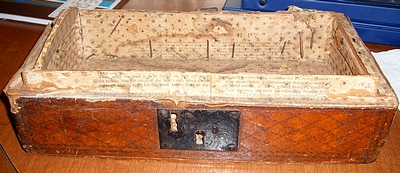
Why did young John travel from England to Virginia? England was in turmoil in the late 1640's. The English civil war had just ended. Victorious Puritans would soon behead the King, Charles I. Oliver Cromwell was in the early stages of his protectorate and still battling competitors for supremacy among their Puritan comrades. As the Puritan government became established, Englishmen who supported the monarchy found that England was no longer a safe haven for them. Not only might they lose their financial wealth, some were in danger of losing their heads if they remained in England. The Stepney docks must have been frantically busy as entire families and their retainers sought passage out of England. Was it, perhaps, imperative that John Jr. leave the country at this time? Was John Jr. or his parents so closely associated with the Royalist cause that he had to flee for his safety? Or was John simply looking for a better life, the chance to own land and prosper? We will most likely never know the cause of John's immigration to Virginia as an indentured servant.
Many of the original English colonists considered members of the First Families of Virginia
migrated to the Colony of Virginia. This migration took place during the English Civil War and
English Interregnum period (1642–1660), after the first thanksgiving in Virginia (1619) held by
Captain John Woodlief. Royalists left England on the accession to power of Oliver Cromwell and
his Parliament. Because most of Virginia's leading families recognized Charles II as King
following the execution of Charles I in 1649, Charles II reputedly called Virginia his "Old
Dominion" – a nickname that endures today. The affinity of many early aristocratic Virginia
settlers for the Crown led to the term "distressed Cavaliers", often applied to the Virginia
oligarchy. Many Cavaliers who served under King Charles I fled to Virginia. Thus it came to be
that FFVs often refer to Virginia as "Cavalier Country". These men were offered rewards of land,
etc., by King Charles II but they had settled in Virginia and so remained in Virginia.
Most of such early settlers in Virginia were so-called "Second Sons". Primogeniture favored the first sons' inheriting lands and titles in England. Virginia evolved in a society of second or third sons of English aristocracy who inherited land grants or land in Virginia. They formed part of what became the southern elite in America.
In some cases, longstanding ties between families of the English aristocracy simply transplanted themselves to the new colony. In one case, for instance, ancestral ties between the Spencer family of Bedfordshire and the Washington family meant that it was a Spencer who secured the land grant on which the Washingtons would later build their Mount Vernon home. These sorts of ties were common in the early colony, as aristocratic families shuttled back and forth between England and Virginia, maintaining their connections with the mother country and with each other.
The reins of power were held by a thin network of increasingly interrelated families. "As early as 1660 every seat on the ruling Council of Virginia was held by members of five interrelated families," writes British historian John Keegan, "and as late as 1775 every council member was descended from one of the 1660 councillors."
The skein of ties among Virginia families was a legacy of England's ancestral feudalism: in a pre-industrial economy based largely on the possession of land, the ownership of that land was tightly controlled, and often passed between families of corresponding social rank. The Virginia economy, predicated on the institution of slavery and not on mercantile pursuits, meant that the gentry could keep tight rein on the levers of power, which passed in somewhat orderly fashion from family to family. (In the more modern mercantile economy of the north, social mobility became more prominent, and the power of the elite was muted by the forces of the market economy.)
Source: Wikipedia
The first record of John Botwright, Jr. in Virginia is the recording of the land patent to
Humphrey Dennis for John's headright. There is no record of a land certificate issued to
Humphrey Dennis, so it is likely that he acquired the certificate via purchase or trade rather
than the actual importation of John Boatwright. It is also not clear when exactly John emigrated
to America, it would most likely be in 1653 - 1654, as headright certificates were often quickly
converted to land, when possible.
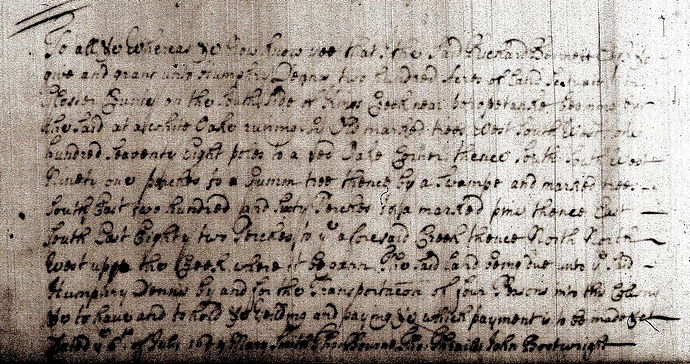
Virginia Land Patents and Grants (book 3, page 322, dated July 6, 1654) records 200 acres granted to Humphrey Dennis, on the south side of Kings Creek, near Poropotank in Glouchester County, Virginia. Headrights for Mary Smith, Thomas Bourne, Thomas Thraile and John Boatwright. These same 200 acres were re-granted as head rights to John Guthrie, noted in the record that the land was "Granted to Humphrey Dennis 1654, deserted". Humphrey Dennis traveled to Virginia as an indentured servant, his head right recorded in 1639 by George Minifye, Esquire, on the north side of the Charles (York) River, beginning at the creek upon the west side of the Indian Fields, opposite Queens Creek and down the river to Timberneck Creek. Kings Creek, Timberneck Creek, Queens Creek and the Poropotank river exist today. The Poropotank river forms the border between Gloucester County and what was then New Kent County (today King & Queen County). The Poropotank river feeds into the York River.
The second record of John Botwright, Jr. in Virginia is the recording of the land certificate to John Botwright for 400 acres of land for the importation of William Powell, Thomas Cropley, William Cropley, John Botwright, Henry Farloe, James Cassett, Elizabeth Bridge and Anne Scarlett; recorded January 24, 1657, York County, Virginia. This key record, discovered by Dr. Ron Boatright, records John Botwright Jr. receiving a land certificate for 400 acres for importing eight individuals including his father (John Botwright Sr.) and two uncles (Thomas and William Cropley). The Cropleys were brothers to John Sr.'s wife, Elizabeth Cropley. It is assumed that John Sr.'s wife, Elizabeth Cropley Boatwright, had died in England by this time. There is no subsequent record of a land patent for the 400 acres by John Boatwright, so it is assumed that John sold or traded the land certificate rather than claiming the 400 acres of land. The record of John Jr. paying for the passage of eight individuals, just three years after he was imported, indicates that he had successfully transitioned to the new world of Virginia.

"Cert. is granted to Mr. John Botwright for four hundred acres of land for ye importeen of William Powell, Thomas Cropley, William Cropley, John Botwright, Henry Farloe, James Cassett, Elizabeth Bridge and Anne Scarlett."
The third record of John Botwright, Jr. in Virginia is the recording of John Botwright headright by Thomas Ballard, assigned to William Light; recorded December 21, 1657, York County, Virginia. This record indicates that John has traveled back to England, with the return trip paid for by Thomas Ballard. John Botwright appears to be closely associated with Thomas Ballard, perhaps serving his indenture under Thomas Ballard. Dr. Ron Boatright believes that John Botwright made several trips back to England, perhaps to purchase items for Thomas Ballard.

"Cert (certificate) to William Light assignment of Thomas Ballard for 300 acres of land for transportation of Joane Cooke, Morock-o-Royal, Robert Strong, John Botwright, Hester Hickes and Thomas Wolfe into this Colony"
The fourth record of John Botwright, Jr. in Virginia is the witnessing of a will for William Thomas, father-in-law to Thomas Ballard; recorded June 24, 1659, York County, Virginia. Wills were often written when a person of wealth was traveling back to England. The other witness on the document is James Bray, a York County, Virginia attorney; appearing frequently during this time period in the York County Court records.
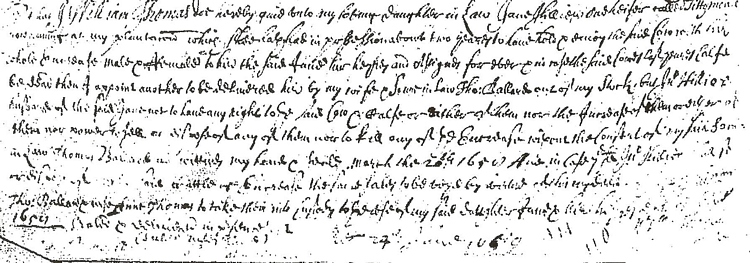
The fifth record of John Botwright, Jr. in Virginia is the witnessing of a statement by Thomas Ballard; the ages of Thomas Ballard (29) and John Botwright (24) are included in the statement; recorded November 17, 1659, York County, Virginia.
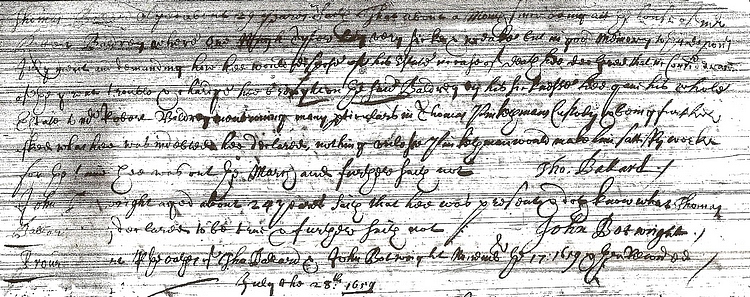
"Thomas Ballard aged about 29 years Saith that about a month since being att the house of Mr. Robert Baldrey, where one Hugh Tyler lay very sicke & weake but in good memory in this Deponents judgement and demanding how hee would Dispose of his Estate in case of Death hee Declared that in Consideration of ye great trouble & charges hee brought on ye said Baldrey by his sickness he gave his whole Estate to Mr. Robert Baldrey, mentioning many particulars in Thomas Pinkethman Custody & being further asked what hee was indebted hee declared, nothing ______ Pinkethman would make him satisfy worke for ye time hee was out ye March and further Saith not.
Thomas Ballard (signature)
John Botwright aged about 24 years Saith that hee was present & doth know what Thomas Ballard hath declared to be true & further Saith not.
John Botwright (signature)
Proved in court by ye oaths of Tho. Ballard & John Botwright - November 17: 1659 and ye Recorded".
The sixth record of John Botwright, Jr. in Virginia is the witnessing of a second will for William Thomas, father-in-law to Thomas Ballard; recorded July 2, 1661, York County, Virginia. In the will, William Thomas states that he is traveling to England aboard the ship "Honor" of London. Once again, the other witness is James Bray, York County, Virginia attorney.
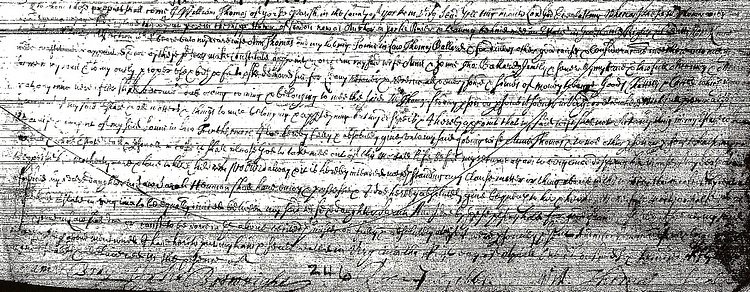
Sometime after 1661, John Jr. purchased 250 acres of land in St. Peter's parish located in New Kent County. This land passed down to his son, John III and is recorded in the 1704 Quit Rent rolls for New Kent County. St. Paul's parish is located in what was then New Kent County but today is Hanover County, formed in 1720 from a portion of New Kent County. It would appear by these records that John Jr. settled in what was originally York County but became New Kent County and eventually Hanover County. Because of the burning of the New Kent and Hanover court house records, many valuable records including land purchases and sales, to further substantiate John Sr., John Jr. or John III's lives, have been lost.
Children of JOHN BOTWRIGHT, JR. and ELIZABETH are:
i. ELIZABETH BOATWRIGHT, b. ca. 1677, Virginia.
3. ii. JOHN BOATWRIGHT, III, b. ca. 1680, Virginia; d. Unknown, New Kent
County, Virginia.
2B. LETTICE BOTWRIGHT (JOHN2, Not Yet Determined1) was born ca. 1637 in Cambridge, Cambridgeshire, England, and died 1639 in Cambridge, Cambridgeshire, England.
Notes for LETTICE BOTWRIGHT:
Lettice was baptised at the Great St. Mary's Church in Cambridge, England on January 13, 1637.
Lettice was buried on July 15, 1639 in Cambridge, Cambridgeshire, England. Burial record indicates she was the daughter of John and Elizabeth.
2C. EDWARD BOTWRIGHT (JOHN2, Not Yet Determined1) was born 1640 in Cambridge, Cambridgeshire, England, and died 1640 in Cambridge, Cambridgeshire, England.
Notes for EDWARD BOTWRIGHT:
Edward was buried on June 1, 1640 in St. Edward King and Martyr Church, Cambridge, Cambridgeshire, England.
2D. ELIZABETH BOTWRIGHT (JOHN2, Not Yet Determined1) was born ca. 1641 in Cambridge, Cambridgeshire, England, and died 21 Nov 1651 in Cambridge, Cambridgeshire, England.
Notes for ELIZABETH BOTWRIGHT:
Elizabeth was baptised at St. Edward King and Martyr Church in Cambridge, England in 1641.
Elizabeth was buried on November 26, 1646 in St. Edward King and Martyr Church, Cambridge, Cambridgeshire, England.
The Church burial record for Elizabeth includes the comment: "daughter of Mr. John Botwright died November 21, buried November 26 in South Chancel."
2E. JANE BOTWRIGHT (JOHN2, Not Yet Determined1) was born ca. 1646 in Cambridge, Cambridgeshire, England, and died 1646 in Cambridge, Cambridgeshire, England.
Notes for JANE BOTWRIGHT:
Jane was baptised at St. Edward King and Martyr Church in Cambridge, England on August 29, 1646. Baptism record indicates she was the daughter of John and Elizabeth.
Jane was buried on October 18, 1646 in St. Edward King and Martyr Church, Cambridge, Cambridgeshire, England.
The Church burial record for Jane includes the comment: "In the South Chansill the clerk had for the purforemanc of his duty 4 shillings."
2F. MABLE BOTWRIGHT (JOHN2, Not Yet Determined1) was born ca. 1648 in Cambridge, Cambridgeshire, England.
Notes for MABLE BOTWRIGHT:
Mable was baptised at St. Edward King and Martyr Church in Cambridge, England on January 24, 1648. Baptism record indicates she was the daughter of John and Phebe.
Boatwright/Boatright Family Genealogy Website
last modified: October 10, 2014
URL: http://www.boatwrightgenealogy.com
Navigation / Home / DNA Project / Name Index / Pictures / Stories / Obits / Generation 1 / Generation 3